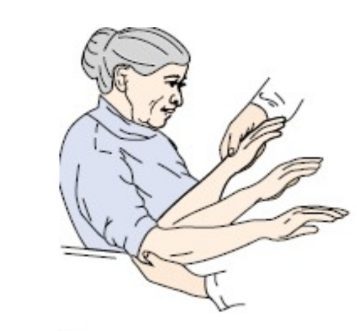Contents
Bradykinésie
Bradykinesia is a motor disorder characterized by the slowing of voluntary movements, generally associated with akinesia, that is to say a rarity of these movements. This motor slowdown is typical of Parkinson’s disease, but may be related to other neurological or psychiatric conditions.
Bradykinesia, what is it?
Definition
Bradykinesia is a motor disorder that is defined as slowness in the execution of movements without loss of muscle strength. This slowing down is generally associated with a difficulty in initiating movement which can go as far as total incapacity, called akinesia. It can concern all the range of motor acts of the limbs (in particular walking or face (facial expressions, speech, etc.).
Causes
Main symptom of Parkinson’s disease, bradykinesia is also found in other neurological conditions grouped under the term parkinsonian syndrome. In these pathologies, there is a degeneration or damage to the cerebral structures forming what is called the extra-pyramidal system and a dysfunction of the dopamine neurons involved in the regulation of movement.
Disturbances in cerebral functions leading to psychomotor slowing down, or even states of stupor in which all motor activity is suspended, are also observed in various psychiatric conditions.
Diagnostic
The diagnosis of bradykinesia is primarily based on physical examination. Various tests, timed or not, are likely to objectify the slowing down of the movement.
Several scales developed for the assessment of motor disorders in Parkinson’s disease offer a measure of the course of bradykinesia:
- The MDS-UPDRS scale (scale Unified Parkinson’s Disease Rating Scale modified by Movement Disorder Society, a learned society specializing in movement disorders) is commonly used. It is used to assess the speed of execution of different tasks, such as repeated movements of the hands (alternating movements, tapping of the fingers, etc.), the agility of the legs, getting up from a chair, etc.
- We also use a computer application called Brain Test (bradykinesia akinesia incoordination test), which measures the speed of typing on a keyboard.
On a more experimental basis, we can also use motion sensors or 3D motion analysis systems. Actimeters – devices that record movement, in the form of a watch or a bracelet – can also be used to assess the slowing down of movement in everyday situations.
The people concerned
These are mainly people with Parkinson’s disease, but other neurological and psychiatric disorders are also accompanied by bradykinesia, including:
- supra-nuclear paralysis,
- multisystem atrophy,
- striatum-black degeneration,
- cortico-basal degeneration,
- Lewy body disease,
- parkinsonian syndrome induced by taking neuroleptics,
- catatonia,
- the Depression,
- bipolar disorder,
- certain forms of schizophrenia …
Risk factors
Age remains the main risk factor for neuronal dysfunction, but environmental factors (exposure to toxicants such as pesticides, taking psychotropic drugs, etc.) as well as genetic susceptibility can also play a role in the appearance of bradykinesia.
Symptoms of bradykinesia
Most often, bradykinesia and akinesia set in gradually, increasingly affecting everyday tasks. People who suffer from these disorders describe sensations similar to those experienced under chemical straitjacket. To chain and coordinate his movements ends up becoming an ordeal. Emotion or fatigue further complicate their execution.
Hand motor skills
The gestures accompanying speech are becoming rarer and simple activities such as eating meals are slowed down.
Precise and / or repetitive movements are affected: it becomes difficult to button a coat, to tie your shoes, to shave, to brush your teeth … Writing in fly paws (micrograph) is another consequence of these disorders. .
Walk
Hesitations at the initiation of walking are frequent. Affected people adopt a characteristic small step, slow and punctuated by trampling. The automatic swing of the arms disappears.
Facial motor skills
The face becomes frozen, deprived of facial expressions, with increasingly rare blinking of the eyes. Slower swallowing can result in excess saliva. Speaking is delayed, with the voice sometimes becoming monotonous and low.
Treatments for bradykinesia
Medical treatment
Treatment of associated pathologies can improve motor skills. L-Dopa, a precursor of dopamine constituting the cornerstone of the treatment of Parkinson’s disease, is particularly effective.
Deep brain stimulation, also used to reduce neurological symptoms in Parkinson’s disease, also has a positive effect on bradykinesia and akinesia.
Re-education
Rehabilitation does not correct neurological disorders but is useful in reducing their effects. Unfortunately, its effects tend to wear off in the absence of training.
Various motor management strategies are possible:
- Muscle building can be beneficial. In particular, there is an improvement in walking parameters after strengthening the leg muscles.
- Rehabilitation is also based on cognitive strategies: it involves learning to focus your attention on movements (concentrating on taking big steps while walking, swinging your arms exaggeratedly, etc.).
- Adapted from an approach first used to rehabilitate speech disorders, the patented LSVT BIG protocol ((Lee Silverman Voice Treatment BIG) is an exercise program that relies on the repeated practice of large amplitude movements. It also alleviates the consequences of bradykinesia.
Prevent bradykinesia
In people with neurological disorders, the continuity of physical activities can delay the manifestations of bradykinesia and reduce its effects.










